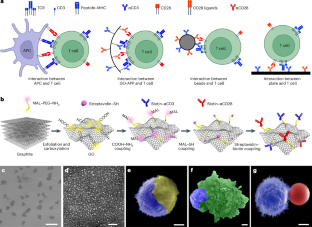Biomimetic cell stimulation with a graphene oxide antigen-presenting platform for developing T cell-based therapies
IF 34.9
1区 材料科学
Q1 MATERIALS SCIENCE, MULTIDISCIPLINARY
引用次数: 0
Abstract
Chimeric antigen receptor (CAR)-engineered T cells represent a front-line therapy for cancers. However, the current CAR T cell manufacturing protocols do not adequately reproduce immunological synapse formation. Here, in response to this limitation, we have developed a flexible graphene oxide antigen-presenting platform (GO-APP) that anchors antibodies onto graphene oxide. By decorating anti-CD3 (αCD3) and anti-CD28 (αCD28) on graphene oxide (GO-APP3/28), we achieved remarkable T cell proliferation. In vitro interactions between GO-APP3/28 and T cells closely mimic the in vivo immunological synapses between antigen-presenting cells and T cells. This immunological synapse mimicry shows a high capacity for stimulating T cell proliferation while preserving their multifunctionality and high potency. Meanwhile, it enhances CAR gene-engineering efficiency, yielding a more than fivefold increase in CAR T cell production compared with the standard protocol. Notably, GO-APP3/28 stimulated appropriate autocrine interleukin-2 (IL-2) in T cells and overcame the in vitro reliance on external IL-2 supplementation, offering an opportunity to culture T cell-based products independent of IL-2 supplementation. Current CAR T cell manufacturing falls short of mimicking immunological synapses. A new graphene oxide antigen-presenting platform (GO-APP) addresses this issue, improving CAR T cell production while eliminating the need for interleukin-2 supplementation.


利用氧化石墨烯抗原递呈平台进行仿生细胞刺激,开发基于 T 细胞的疗法
嵌合抗原受体(CAR)工程 T 细胞是治疗癌症的一线疗法。然而,目前的 CAR T 细胞制造方案无法充分再现免疫突触的形成。针对这一限制,我们开发了一种灵活的氧化石墨烯抗原递呈平台(GO-APP),可将抗体锚定在氧化石墨烯上。通过在氧化石墨烯(GO-APP3/28)上装饰抗 CD3(αCD3)和抗 CD28(αCD28),我们实现了显著的 T 细胞增殖。GO-APP3/28 与 T 细胞之间的体外相互作用密切模拟了体内抗原递呈细胞与 T 细胞之间的免疫突触。这种免疫突触模拟显示了刺激 T 细胞增殖的强大能力,同时保留了 T 细胞的多功能性和高效力。同时,它还提高了 CAR 基因工程的效率,与标准方案相比,CAR T 细胞的产量增加了五倍以上。值得注意的是,GO-APP3/28 能刺激 T 细胞产生适当的自分泌白细胞介素-2(IL-2),克服了体外培养对外部 IL-2 补充的依赖,为不依赖 IL-2 补充培养基于 T 细胞的产品提供了机会。
本文章由计算机程序翻译,如有差异,请以英文原文为准。
求助全文
约1分钟内获得全文
求助全文
来源期刊

Nature nanotechnology
工程技术-材料科学:综合
CiteScore
59.70
自引率
0.80%
发文量
196
审稿时长
4-8 weeks
期刊介绍:
Nature Nanotechnology is a prestigious journal that publishes high-quality papers in various areas of nanoscience and nanotechnology. The journal focuses on the design, characterization, and production of structures, devices, and systems that manipulate and control materials at atomic, molecular, and macromolecular scales. It encompasses both bottom-up and top-down approaches, as well as their combinations.
Furthermore, Nature Nanotechnology fosters the exchange of ideas among researchers from diverse disciplines such as chemistry, physics, material science, biomedical research, engineering, and more. It promotes collaboration at the forefront of this multidisciplinary field. The journal covers a wide range of topics, from fundamental research in physics, chemistry, and biology, including computational work and simulations, to the development of innovative devices and technologies for various industrial sectors such as information technology, medicine, manufacturing, high-performance materials, energy, and environmental technologies. It includes coverage of organic, inorganic, and hybrid materials.
 求助内容:
求助内容: 应助结果提醒方式:
应助结果提醒方式:


